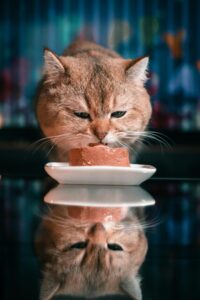Unlock the Secrets of Cat Food Labels for Optimal Feline Nutrition
Although it may seem trivial at first, reading cat food labels is essential for ensuring that your furry friend receives the nutritional balance necessary for a long and healthy life. These labels are not just marketing materials; they are informative guides that provide critical insights into the quality and composition of your cat’s diet. By learning to interpret this information, you can make educated choices that significantly enhance your cat’s overall well-being and longevity. This knowledge equips you to select the best food options tailored to your cat’s specific needs, ultimately contributing to a happier and healthier life for your pet.
Understanding the specific terminology found on cat food labels is a foundational element for pet owners. Phrases like “complete and balanced” indicate that the food meets the nutritional criteria set by the Association of American Feed Control Officials (AAFCO). Familiarizing yourself with these terms enables you to choose foods that provide the essential nutrients your cat requires to thrive. This knowledge empowers you to opt for diets that are specifically formulated to meet your cat’s unique health needs, ensuring they receive the best possible nutrition.
As you delve deeper into cat food packaging, you will encounter terms such as ‘natural’ and ‘organic’. While these labels can be enticing, their meanings differ significantly and can affect the perceived quality of the food. The term ‘natural’ generally signifies the absence of artificial additives, but it does not necessarily imply that the product is of high quality. On the other hand, ‘organic’ refers to stringent production methods that typically ensure a higher standard of safety and quality, making it a preferred option for discerning pet owners who prioritize their cat’s health.
The AAFCO plays a pivotal role in establishing nutritional standards within the pet food realm. Their guidelines ensure that any product labeled as ‘complete and balanced’ meets specific nutritional requirements tailored to various life stages of cats. Understanding these labels is paramount for pet owners striving to make informed dietary choices for their cats. By leveraging this invaluable information, you can confidently select the best food options that cater to your feline companion’s distinctive dietary needs.
Having a thorough understanding of the information on your cat’s food label can dramatically enhance your ability to make nutritious choices that benefit their health and well-being. The insights you gain will empower you to select high-quality food that meets your cat’s specific dietary requirements, thus paving the way for a healthier and happier life.
 Essential Insights for Deciphering Cat Food Ingredients Effectively
Essential Insights for Deciphering Cat Food Ingredients Effectively
A critical element of understanding cat food labels involves meticulously analyzing the ingredients list. Typically, ingredients are listed in order of weight before cooking, meaning the first few items represent the primary components of the food. This hierarchy is essential, as it gives you a clear picture of what your cat is consuming daily, allowing you to make more informed dietary choices.
Given that cats are obligate carnivores, it’s crucial for protein sources to take precedence on the ingredient list. Look for specific proteins such as chicken, beef, or salmon listed at the top, rather than generic terms like ‘meat meal’. This specificity not only reflects a higher quality and more nutritious diet but also aligns with your cat’s natural dietary preferences, ensuring they receive the protein necessary for their health and vitality.
It’s equally important to identify and minimize certain additives and fillers in your cat’s food. Ingredients like corn, soy, or wheat gluten may enhance the food’s volume but offer minimal nutritional benefits for felines. Instead, prioritize options rich in whole grains and vegetables, as these provide healthier alternatives and contribute to a well-rounded, nutritious diet that supports your cat’s overall health.
Be vigilant about artificial preservatives commonly found in pet foods, such as BHA, BHT, and ethoxyquin. Although these substances are often included to extend shelf life, they may not be the healthiest options for your feline companion. Opt for foods that utilize natural preservatives like vitamin E (tocopherols) or vitamin C (ascorbyl palmitate) to help maintain the quality of their diet without compromising their health.
If you come across unfamiliar or complex ingredient names, take the time to research them. Being informed about what your cat consumes is the best way to ensure you are making educated choices that promote their health and well-being, allowing you to provide a diet tailored to their individual needs.
A Comprehensive Approach to Analyzing Nutritional Content for Your Cat
Understanding the Guaranteed Analysis section on cat food labels is vital for gaining insights into the nutrient content of the food. This section typically specifies the minimum or maximum percentages of crude protein, fat, fiber, and moisture. Achieving the right balance of these nutrients is essential for maintaining your cat’s overall health and vitality.
The protein content is a primary consideration when selecting cat food. Cats require significant levels of protein to flourish, so it’s crucial to ensure that adequate amounts come from animal sources, which offer the essential amino acids they need. Avoid foods that heavily rely on plant-based proteins, as these often lack the complete range of nutrients necessary for optimal feline health.
Carbohydrate content is another critical factor to consider when evaluating cat food. While some carbohydrates can be beneficial in moderation, they should not dominate the ingredient list, especially for cats that may be prone to weight gain. Aim for foods that emphasize higher protein and lower carbohydrate levels to support a healthy, balanced diet that meets their specific energy needs.
Essential nutrients, including taurine, are vital for your cat’s overall health. Taurine is necessary for maintaining heart and eye health, and since cats cannot synthesize it independently, it is crucial to ensure that your chosen food contains this indispensable component. Always verify the label to confirm that taurine is included, as it plays a significant role in your cat’s well-being.
Be vigilant about potential allergic reactions in cats that may result from specific food ingredients or dietary imbalances. Common allergens can differ among individual cats, so it’s important to observe your pet closely for any adverse reactions. If necessary, consider exploring hypoallergenic food options specifically designed for sensitive cats to ensure they receive a diet that supports their health.
 Proven Tips for Choosing the Best Cat Food Tailored to Your Feline’s Needs
Proven Tips for Choosing the Best Cat Food Tailored to Your Feline’s Needs
Selecting the best food for your cat is about more than just choosing the product with the most attractive packaging. It involves aligning the nutrition with your cat’s unique needs and lifestyle. When making your selection, consider pivotal factors such as your cat’s age, activity level, and any specific health conditions they may have. A tailored approach ensures that your cat receives the appropriate diet for their individual requirements.
Customizing the diet to match your cat’s lifestyle can significantly affect their health and vitality. For instance, an active outdoor cat will typically require more calories and protein than a more sedentary indoor cat. Monitoring their daily activities can guide you in providing a diet that adequately supports their energy demands and overall well-being.
Price does not necessarily equate to quality, so it is essential not to let cost dictate your choice. You may find that you are paying a premium for branding rather than actual nutritional benefits. Understanding the implications of ingredients and the nutritional breakdown is far more critical for your cat’s health than the price tag of the product.
Bear in mind that pet food brands frequently modify their recipes, sometimes subtly and other times significantly. Staying updated on these changes ensures that you are aware of what is being served in your cat’s bowl. Regularly checking for updates from brands can help you avoid unexpected dietary shifts that may adversely affect your cat’s health.
Lastly, consulting with your veterinarian can provide personalized insights tailored to your cat’s specific health needs. A veterinarian can recommend suitable foods that address dietary restrictions or health concerns, giving you peace of mind that your cat is receiving the optimal nutrition necessary for a fulfilled, healthy life.
The Article : How To Interpret Your Cat’s Food Labels Appeared First On Unity Pets.
The Article Interpreting Cat Food Labels: A Quick Guide Was Found On https://limitsofstrategy.com


Reading your blog post brought back memories of my early days as a cat owner. At first, I often found myself overwhelmed by the myriad of options available in pet stores, and I confess, I mostly chose cat food based on colorful packaging or catchy names. It wasn’t until my beloved Maine Coon, Oliver, started showing signs of lethargy and poor coat condition that I realized the importance of understanding cat food labels. This experience taught me that even the tiniest adjustments in a cat’s diet can make a tremendous difference in their health and vitality.
I can totally relate to your experience with Oliver. Learning to navigate the overwhelming world of pet food options feels like a rite of passage for many cat owners. It’s fascinating how the marketing can pull us in with flashy designs and clever names, but it really takes hands-on experience, like yours with Oliver, to understand what truly matters.
Your reflections on choosing the right cat food resonate with me; it reminds me of how important it is to be mindful about nutrition, not just for our pets, but for ourselves too, especially when it comes to maintaining a healthy weight.
‘Healthy Weight Loss – Fat Loss Tips and Tactics’
https://pier3.org/healthy-weight-loss-fat-loss-tips-and-tactics/.
Your experience resonates with so many of us who have ventured into the world of cat ownership, and it’s often a journey filled with some trial and error. Starting off with a Maine Coon like Oliver must have been quite an adventure! Those big, fluffy personalities can really steal your heart, can’t they?
It really is a journey, isn’t it? Bringing a Maine Coon like Oliver into the mix has definitely been a memorable experience. Their personalities are just so unique—one moment they’re these majestic, fluffy creatures, and the next, they’re bouncing around like playful kittens. It’s hard not to fall for their charm.
It’s great to hear about your journey with Oliver! The early days of pet ownership can really feel like navigating a maze, especially with so many flashy options out there. It’s all too easy to be drawn in by packaging and marketing. Like you, many of us have faced that moment when we realize our choices might not be serving our pets the way we thought.
Navigating the early days of pet ownership feels like a maze for sure. Those decisions about food, toys, and even training methods can quickly become overwhelming. When I first brought Oliver home, I fell right into the marketing trap. The vibrant packaging and flashy claims had me convinced I was giving him the best possible start. But as you pointed out, there comes that moment of realization when you start to question if what looks appealing on the surface truly aligns with your pet’s needs.